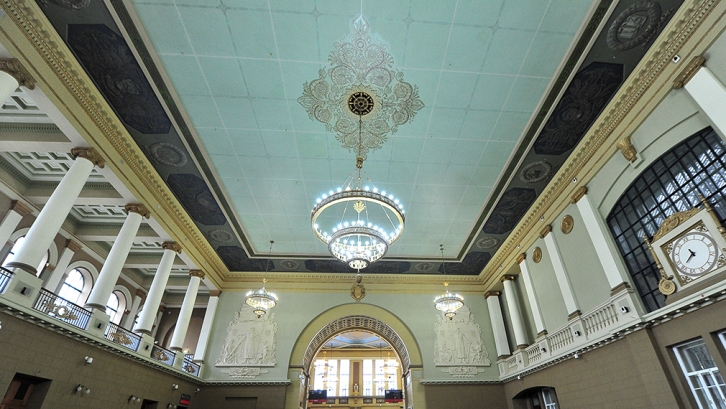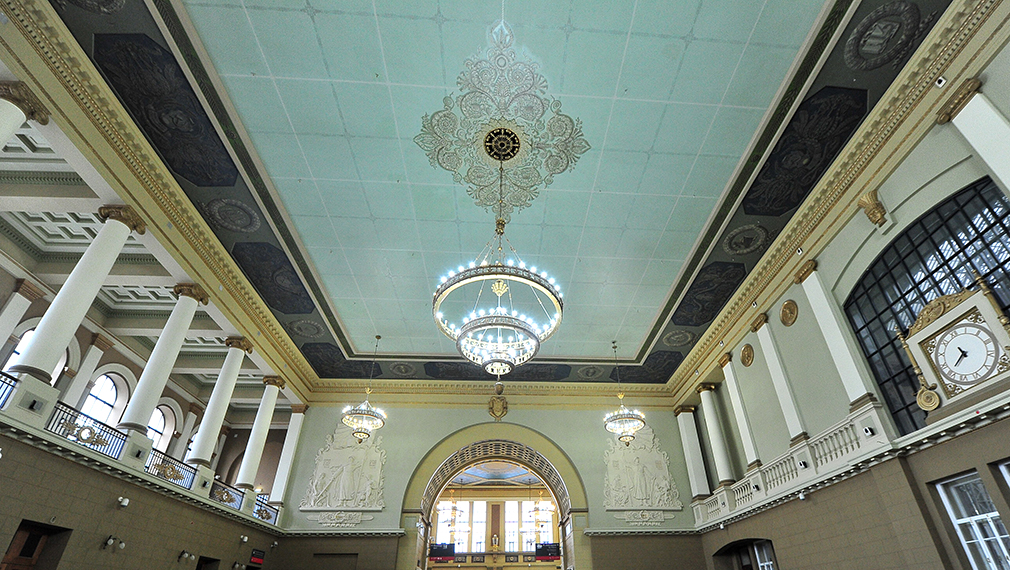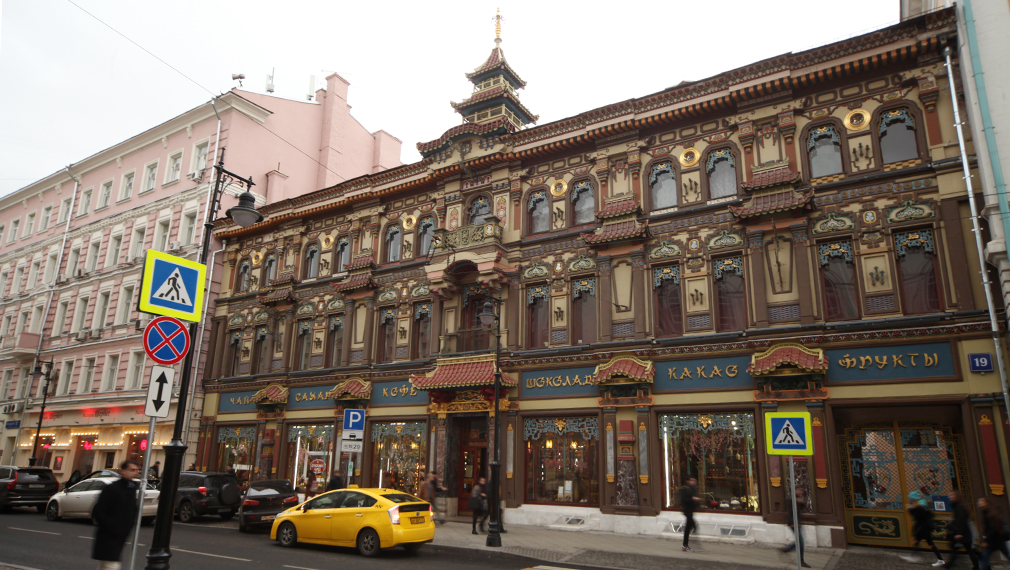Moscow’s largest fresco, jellyfish lamp and majolica panels

Over 700 churches, theatre buildings, mansions, residential houses and other landmarks have been restored in Moscow in recent years. Mos.ru reveals which restaurant features niches for icon lamps and where a house decorated with ornate artwork showing dragons, snakes and Chinese umbrellas is located.
Moscow’s Cultural Heritage Site Restoration Programme is one of the world’s most ambitious projects of its kind. Over the past six years, the city has carried out 773 restoration projects. The condition of over 90 percent of the city’s cultural heritage sites is good.
The Kremlin’s Spasskaya Tower, VDNKh pavilions, fountains at Luzhniki, the main entrance to Gorky Park, the Marina Tsvetayeva Memorial Flat, the Gagarin House, the old mansion that was owned in turn by the Shakhovskoi, Glebov and Streshnev families, which currently houses the Gelikon Opera Theatre, and the Ruina Museum located in a wing of the mansion of the Talyzin family – this list of sites that have been restored in recent years is far from complete.
The Donskoi Monastery’s oldest church and Moscow’s largest wall fresco
In 2016, the Church of Our Lady of the Don at 1 Donskaya Square celebrated two occasions – the 425th anniversary of its foundation and the completion of restoration work. The Donskoi Monastery’s oldest church, it was built by masters taken on by Boris Godunov in the late 16th century. Specialists found 16th-century windows with profiled brick frames on the church’s western wall. The church renovation project included the doorways to the side altar and the refectory, the metal cross with carvings and ornamented tiles covering the belfry’s open bell tier parapet walls. Also, the domes were covered with copper and gilded.
In 2016, work was completed at the Chernigovskoye Metochion (town residence) on Pyatnitskaya Street and Chernigovsky Pereulok. It embraces some of the landmarks of Moscow ecclesiastical architecture of the 17th-century. The project provided for the renovation of the façade, roof and ornate artwork of the Church of the Beheading of St John the Baptist at the Pine Forest and the reconstruction of the fresco depicting St John the Baptist, Moscow’s largest wall fresco.

Majolica panels at Kievsky Railway Station and motley granite floor covering at Kievskaya metro station
Paintings, majolica panels and sculptures have been restored to Kievsky Railway Station at 1 Kievskogo Vokzala Square, which dates back to the 19th century. Now one can take delight in the play of bright colours on one of the two majolica panels on the station’s façade – a relief image of St George the Victorious, Moscow’s patron. The other plate depicts St Michael the Archangel standing up straight. The northern side wall is covered with a plate showing a river flowing out of a jug and flags with Peter the Great’s initials. Paintings in the long-distance train waiting rooms have been restored, while some elements of the interior and even entire halls were painted a different colour.
Another landmark, Kievskaya metro station on the Filyovskaya Line, is located close to the railway station. Using drawings dating back to the 1930s, specialists have managed to restore the central part of the floor of the platform, which resembles a kaleidoscopic carpet. They have also managed to preserve the majority of the faience heads of the columns at the station. The restoration of the lamps, which were made out of two-layers of glass with diamond facets, proved to be the most difficult part of the work.

Fountains at Luzhniki and landmarks at VDNKh
Things to be admired at Luzhniki Park at 24 Luzhnetskaya Embankment include the renovated façade of the stadium and eight historical fountains; their appearance was restored with utmost accuracy. For example, for lining purposes, workers used the same kind of granite – Rosso Santiago – as was used when the fountains were built in 1956.
This summer, restorers gave the arch of the northern entrance to VDNKh a second lease of life. They have reconstructed the ornate artwork, including stucco work, and, in part, high reliefs. After restoration a famous high relief by Yevgeny Vuchetich, Long Live the Soviet People, a Champion of Peace, is available to the public. Created in 1954, the high relief of 90 square metres showing over 1,500 people was expected to become the centerpiece of VDNKh’s main pavilion. Many believe that this three-dimensional composition is several metres thick, however, the furthermost figure of the composition is located a mere 62 centimetres in the background, so it can be reached by hand. For 40 years it has been thought that the work was lost forever but in 2014 it was discovered during the restoration of the pavilion.
Niches for icon lamps at Aragvi Restaurant and pagoda at the top of Perlov’s Tea Shop
In the spring of 2016, work to restore the famous Aragvi Restaurant at 6 Tverskaya Street, building 2 was completed. The restoration work helped discover main brick walls and the 17th–18th century artwork. The plasterwork concealed vaulted ceilings, the remains of paintings, doorways with icon cases on their sides and niches for icon lamps.
A new lease of life has also been given to one of Moscow’s most unusual buildings, No. 19 on Myasnitskaya Street. It is Moscow’s first tea shop that was commissioned by Sergei Perlov, a merchant, in the late 19th century. The building of the tea shop is decorated with a pagoda at the top and stucco work showing dragons, snakes, Chinese umbrellas and lamps while inscriptions on the façade are made with a font stylised as Chinese characters. Specialists have reconstructed the missing ornamented tiles and fragments of the stucco work and bells on the pagoda, as well as the gilt in the sales area, paintings on the ceiling and door panels, showcases which have survived since the opening of the tea shop as well as Chinese vases and lamps.

Jellyfish lamp, Gothic doorways and dolomite steps of Moscow’s mansions
In 2016, the mansion of the Zimin family at 8 Degtyarny Pereulok, building 3 was restored. It is a rare example of a rich late 19th-century mansion that has preserved the architectural decoration of its façade and the interior in full. Colourful compositions entitled Summer, Autumn, Winter and Spring are located at the bottom of the main staircase. While working, restorers discovered an old oil storage facility that was not indicated on the drawings.
The initial appearance and exquisite interior of one of the city’s most beautiful buildings, the engine-press house at 9 Tryokhprudny Pereulok, which was run by A. Levenson Partnership, has also been restored. The stain glass dome was reconstructed and a jellyfish lamp, which owes its name to its amusing shape, was installed at the top of the upper twisted pillar. The doors and windows were reconstructed using the drawings of the designer of the house, Fyodor Shekhtel. A low relief depicting print workers can again be seen on the façade of the building, as well as a low relief of Johannes Gutenberg, a man who pioneered the printing press, in a room on the ground floor.
Building 1 at 14 Gogolevsky Boulevard features stucco work with refined gilt, a white marble staircase with a fine brass guardrail banister, a gallery with caryatids, a carved mantelpiece in the Rococo style and fancy mascarons. Feodor Chaliapin, Sergei Rachmaninov and Pyotr Tchaikovsky visited this unique 19th-century mansion at one time. Today, the restored mansion with the façade representing a mixture of styles accommodates the Central House of Chess Players.
Another restored landmark is Nikolai Baulin’s House located at 52 Nikoloyamskaya Street, building 1. Fortunately, the original ground-floor rooms with vaulted ceilings have been preserved. As for the stoves, cornices and parquet, they were copied from those made in the 19th century. The missing upper cornice was made using a pattern and the main staircase was restored by means of using a photograph.
.jpg)
Multicolour storeys of the Commune’s House and majolica panels at Plekhanov University
The Commune’s House at 9 2nd Donskoi Proyezd is the sort of city of the future as seen through the eyes of young Soviet builders. One of the building’s main novelties is a steel framework hidden in the walls that can be used to quickly change the layout of the building. By the summer of 2016, the continuous windows with wooden frames on the façade of the building, which accommodates a dormitory for the students, had been restored. One of the walls on each floor of the building has been painted a bright colour. Now the dormitory features yellow, coral, green, pistachio-green, purple and dark blue storeys.
In the summer of 2016, another restored landmark, the 4th building of the Plekhanov Russian University of Economics complete with a church in the New Russian style, opened at 41 Zatsepa Street. Restorers have reconstructed the dome above the altar, gilded crosses at the top of the church and the belfry, the tent-shaped top of the 4th building of the university and some pieces of the ornate artwork decorating it and have also renovated the attic and ornate artwork on the main façade of the building.
.jpg)
- Tags:
- VDNKh |
- Luzhniki |
- restoration |
- churches |
- architectural landmarks |
- mansions


.JPG)

